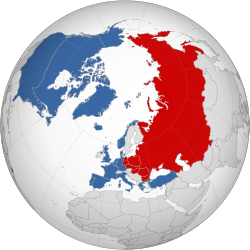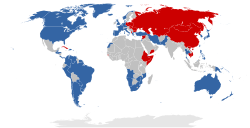
Back Koue Oorlog Afrikaans Kalter Krieg ALS ቅዝቃዛው ጦርነት Amharic Guerra Fría AN Akọn̄ Ofiik ANN शीत युद्ध ANP الحرب الباردة Arabic لحرب لباردة ARY حرب بارده ARZ শীতল যুদ্ধ Assamese
| Cold War | |
|---|---|
| 12 March 1947 – 26 December 1991[A] (44 years and 9 months) Part of the post-World War II era | |
 NATO and Warsaw Pact states during the Cold War era | |
 The "Three Worlds" of the Cold War era, between 30 April and 24 June 1975:
|
| Part of a series on |
| History of the Cold War |
|---|
 |
The Cold War was a period of global geopolitical tension and struggle for ideological dominance and economic influence between the United States and the Soviet Union (USSR) and their respective allies, the Western Bloc and the Eastern Bloc. It started in 1947 and lasted until the fall of the Soviet Union in 1991. The term cold war is used because there was no direct fighting between the two superpowers, though each supported opposing sides in major regional conflicts known as proxy wars. Aside from the nuclear arms race and conventional military deployment, the struggle for supremacy was expressed indirectly via psychological warfare, propaganda campaigns, espionage, far-reaching embargoes, sports diplomacy, and technological competitions such as the Space Race.
After World War II, the USSR installed satellite governments in the territories of Eastern and Central Europe it had occupied, promoted the spread of communism to North Korea in 1948, and created an alliance with the People's Republic of China in 1949. The US declared the Truman Doctrine of "containment" in 1947, launched the Marshall Plan in 1948 to assist in Western Europe's economic recovery, and founded the NATO military alliance in 1949 (which was matched by the Soviet-led Warsaw Pact in 1955). A major proxy war was the Korean War of 1950 to 1953, which ended in stalemate.
United States involvement in regime change during the Cold War included support for anti-communist and right-wing dictatorships, governments, and uprisings across the world, while Soviet involvement in regime change included the funding of left-wing parties, wars of independence, revolutions and dictatorships. As nearly all the colonial states underwent decolonization and achieved independence in the period from 1945 to 1960, many became Third World battlefields in the Cold War. The Cuban Revolution of 1959 installed the first communist regime in the Western Hemisphere, and in 1962, the Cuban Missile Crisis began after deployments of U.S. missiles in Europe and Soviet missiles in Cuba; it is considered the closest the Cold War came to escalating into nuclear war. Another major proxy conflict was the Vietnam War of 1955 to 1975, which ended in defeat for the U.S.
The USSR solidified its domination of Eastern Europe with the crushing of the Hungarian Revolution in 1956 and the Warsaw Pact invasion of Czechoslovakia in 1968. Both powers used economic aid in an attempt to win the loyalty of non-aligned countries. After the Sino-Soviet split between the USSR and China in 1961, the U.S. intervened before Soviet's planned massive nuclear strike on China in 1969 and initiated contacts with China in 1972. In the same year, the US and USSR signed a series of arms control treaties limiting their nuclear arsenals. In 1979, the toppling of pro-US governments in Iran and Nicaragua and a Soviet invasion of Afghanistan again raised fears of war. In 1985, Mikhail Gorbachev rose to leader of the USSR and expanded political freedoms in his country, which led to the fall of the communist regimes of the Eastern Bloc in 1989 and the collapse of the Soviet Union in 1991.
Cite error: There are <ref group=upper-alpha> tags or {{efn-ua}} templates on this page, but the references will not show without a {{reflist|group=upper-alpha}} template or {{notelist-ua}} template (see the help page).